Book Reviews 8
 |
Sonic Wind
The Story of John Paul Stapp and How a Renegade Doctor
Became the Fastest Man on Earth
by Craig Ryan
Softbound, 5.4" x 8.2" x 1.0", 432 pages
ISBN-13: 978-0-631491-910
Liveright (2016)
Recommended Retail Price: $17.95
35 b/w illustrations
|
Reviewed by Tom Fey - 11 Nov 2017
Sonic Wind chronicles in detail the amazing life of Col. John Paul Stapp MD, PhD (1910-1999), “The Fastest Man on Earth”. The son of missionary Baptist parents, Stapp earned a PhD in biophysics in 1940, his MD degree from the University of Minnesota in 1943, and went onto active duty in the U.S. Army Medical Corps in the fall of 1944. Nearing the end of his service, Stapp was posted to the Aeromedical Lab at Wright Field as a project engineer to study pilot escape technology. This posting started his life-long, illustrious, and pioneering work on determining the deceleration force limits of the human body.
Fluent in German, he reviewed all the captured wartime German intelligence regarding ejection seats, then went on to champion the use of rocket and compressed-air driven sleds, a programmed swing seat, and elastic-powered chair-sled to determine the limits of human tolerance to rapid deceleration as well as the effectiveness and evolutionary design of restraint systems. Stapp subjected himself to each of these devices, demonstrating that the human could safely tolerate up to 40 times the force of gravity with properly designed restraint devices. In addition, Stapp managed the series of “Manhigh” parachute jumps from altitudes exceeding 100,000 feet, paving the way for high altitude ejection systems and breaking trail on the largely unknown biophysical risks inherent in the coming age of space flight.
Despite being in the U.S. military, Stapp was adamant about studying the forces of automobile impacts to reduce the ever-growing number of deaths and injuries on American roads in the1950s. He slyly couched his research as serving the safety of the motoring military, yet his findings would have wide application and significant headwinds in the civilian realm. John Paul Stapp was a true scientist with a healthy ego, a diverse intelligence, quirky sense of humor, a complex personal life, a flair for public relations, and a manic drive to find ways to reduce death and injury in the airways and roadways. It is said that Stapp’s pioneering work has indirectly saved more lives than anyone else in history, “The ghosts that never happened”. Author Craig Ryan has produced a nicely balanced, well researched, and finely written book about the perfect, imperfect man at the perfect time to do the dirty work that begets monumental progress. This is an important story, very well told.
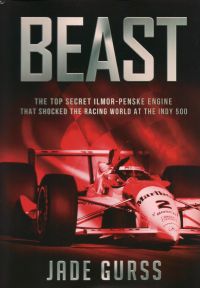 |
Beast
The Top Secret Ilmor-Penske Engine
by Jade Gurss
Hardcover, 9.1" x 6.0" x 1.3", 304 pages
ISBN-13: 978-1937747336
Octane Press (2014)
Recommended Retail Price: $29.95
B/W, color illustrations |
Reviewed by Tom Fey - 22 July 2014
I’m guessing that AEHS members would rank their mechanical interests as aircraft engines first, aircraft themselves as second, and perhaps car/motorcycle/marine/tractor engines as third. As new books on aircraft engines are few and far between, I’d like to suggest our members take a look at the book Beast by Jade Gurss.
It is the fascinating story about the development of a clean-sheet, pushrod V8 engine built in secrecy in just 11 months, specifically for the 1994 Indianapolis 500. Why this engine at this time is an intriguing part of the story. The cast of characters include Paul Morgan, Mario Illien, the determined and fastidious wizards at Britain’s Ilmor Engineering Ltd., Roger Penske, Al Unser Jr., Emerson Fittipaldi, Mercedes-Benz, and the Indianapolis 500 monarchy. This is a fascinating mix of ego, genius, drive, and accomplishment.
The story of the Beast, the Ilmor 265E engine, reads very much like a wartime emergency development program. Every trick, technology, and supplier is chased and cajoled into producing miracles in hours or days instead of weeks or months, in complete secrecy, to exploit a unique window in competitive time.
The book is excellent story-telling that contains sufficient technical detail to satisfy engine lovers, an appropriate dose of open wheel racing history, and some interesting bits of aviation. The author insightfully and authoritatively develops the personalities of the engineers, mechanics, technicians, and designers of the engine as well as those in top management. Their personal recollections and insights are wonderful to read.
With excellent color photographs and outstanding technical drawings, I read the book in one very pleasant summer day. I highly recommend this outstanding book.
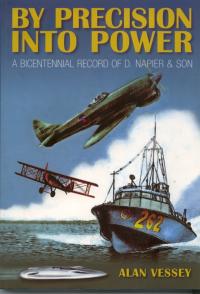 |
By Precision Into Power
A Bicentennial Record of D. Napier & Son
by Alan Vessey
Soft Cover, 9-3/4" x 6-1/4", 256 pages
ISBN: 978 0 7524 3888 7
Tempus
Publishing Ltd
The Mill, Brimscombe Port
Stroud, Gloucestershire
GL5 2QG
United Kingdom
Recommended Retail Price: £19.99
|
Reviewed by Graham White
When we think of Napier the immortal Sabre immediately springs
to mind. However, this long lived company has a rich history going back to 1808.
Author Alan Vessey, who is also Secretary to the Napier Power Heritage Trust,
has written other books on the products of Napier but never one that covers the
company's entire 200 year history, as this one does. And what a history it is.
The fledgling company cut its teeth on products such as
printing presses and precision weighing machines for coins. However, the real
meat of the book, at least for aircraft engine enthusiasts, starts with WWI and
the Napier Lion. All previous documentation has indicted that Rowledge, who
later moved on to Rolls-Royce after a dispute, was responsible for the Lion's
design. Although author Vessey credits Rowledge with much of the development
most of the accolades go to Montague Napier for the Lion's design — this came as
a surprise to this reviewer.
Napier was among the early manufacturers of luxury automobiles
plus commercial trucks. These and Napier's other products of the period are well
covered. Many land speed record cars were powered by Lions, the ultimate being
the Railton Special driven by John Cobb to a world speed record in 1947, a
record that held until the mid 1960s. Likewise, many water speed boats were
powered by Lions. The dubious means by which Rolls-Royce captured control of the
bankrupt Bentley is briefly covered. Reading between the lines one cannot help
thinking what would have happened if Napier had been successful in their
acquisition bid for Bentley … Schneider Trophy aircraft powered by Lions are also
covered.
By the early 1930s we get into the Halford era whereby Frank
Halford acted as a consultant and designed the Rapier, Dagger and Sabre. Having
spent most (all?) of his career with Napier it is perhaps understandable, that
the author did not go into great detail about the Sabre's woes and glossed over
the assistance that Bristol gave (was forced to give?) for Sabre sleeve
production. Development of a two stage, intercooled Sabre driving
contra-rotating propellers was a fascinating insight as to where development was
heading. Of course this did not happen; instead Rolls-Royce developed their
version known as the Eagle 22.
Post war developments include the incredible Deltic two-stroke
Diesel. Although never intended for aircraft propulsion it was built to aircraft
standards with regard to precision and light weight. Non starters, such as the
Nomad turbo compounded two-stroke aircraft Diesel, are also described. Entering
the gas turbine field late in the game made it a tough chore for Napier to catch
up even though the company produced some excellent engines. Reading between the
lines it was apparent that after about the late 1950s a slow decline started. It
was somewhat reminiscent of the decline of Wright Aeronautical. Finally in 1974
the name Napier disappeared and sadly these days few people have even heard of
the name.
A few inevitable errors crept in such as describing George
Eyston's Thunderbolt car as being powered by Merlins. In fact this land speed
record car was powered by a pair of "R" engines. However, this should not put
off a potential purchase; this book represents an excellent read and is highly
recommended.
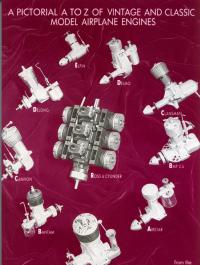 |
A Pictorial A to Z of Vintage and Classic
Model Airplane Engines
From the collection of Mike Clanford
Soft Cover, 8-1/4" x 11-1/2", 213 pages
ISBN: 0-9512524-0-2
Traplet Publications Limited
Traplet House, Pendragon Close, Malvern
Worcestershire WR14 1GA
United Kingdom
Recommended Retail Price: US $47.95
|
Reviewed by Graham White
Most, if not all of us enamored with
aircraft engines started our infatuation with model aircraft engines. If you
want to take a walk down memory lane then this book is for you. I was delighted
to see engines such as the E.D. Competition Special, my first engine, featured.
Even though the Competition Special was a pretty awful engine it has the
distinction getting me started with my passion. Engines from all over the world
are covered, many of which I had never heard of and many more were, and still
are in many cases, household names. All the major manufacturers are covered
along with unique and one-offs. Each engine is featured with a photograph and
brief caption. The book has no text, however, it would have been nice to see a
more extensive write-up on the engines. Understandably, little information is
available on the more obscure engines but engines such as the ETA 29 (a favorite
of mine for Class B Team Racing) and other more common ones could have benefited
from better descriptions. If you are nostalgic about the model engines you
played with as a youngster then this book is a recommended buy.
 |
The Knife and Fork Man
The Life and Work of Charles Benjamin Redrup
by Bill Fairney
Hard Cover, 24cm x 16cm, 343 pages
IISBN: 978-0-9554455-0-7
Diesel Publishing
2, The Tithe Barn, Hawkesbury Upton
Badminton, South Glos
GL9 1AY
United Kingdom
Recommended Retail Price: £14.95
Many Illustrations, Colour and Black & White
|
Review by Jerry Wells
Charles Redrup enjoyed what most people would consider to
be a very fortunate life. He was born in 1878 of wealthy parents who lived in
South Wales, UK. Such was the availability of family money that all ten of the
Redrup children (of which Charles was the first) were able to receive a good
private education. Furthermore, at the age of just 16, Charles' parents bought
him a house near the family home in the coastal town of Barry. Money was
provided to set up a workshop (including a lathe) for the boy to foster his
growing engineering interests and, on top of all this, he was signed up as a
Premium Engineering Apprentice (i.e., the parents pay the employer for
the instruction) with the Great Western Railway for a five year period.
From this beginning, Charles Redrup was able to pursue his
love of engineering for the whole of his life and he did this mostly in England
working sometimes for established firms and sometimes with a few private
partners.
In his time, he designed rotary, radial, and axial engines
for motorbikes, cars and aircraft. He started his married life in the
aforementioned parental-gifted house and by 1925 Charles and Jessie Redrup had a
family of eight.
Professor Fairney does his best to describe the huge
variety of Redrup engines but struggles a bit. For instance, the first Redrup
engine was a small, 2-cylinder rotary for motorcycle use (known as the "Barry"
engine). The author provides a drawing, a photo and a written description of the
device but there are major discrepancies between the drawing and the picture and
the description doesn't do much to reconcile the two graphics. Fortunately, the
patent (GB 1904 13314) can be easily downloaded from the Espacenet site to
clarify the situation.
Redrup next turned his attention to engines for balloons
and early aircraft. His first designs were described by him as "reactionless",
i.e., the radial cylinders (sometimes with a propeller attached; sometimes
without) rotated in the opposite direction to the crankshaft and propeller. The
first "reactionless" was a 2-cylinder development of the "Barry" engine with
push-pull propellers, the next, according to Fairney was "a contra-rotating
radial aero-engine which had three cylinders and an epicyclic gearbox" but the
photograph provided shows this to be a five cylinder motor with bevel
gears (much like the Siemens-Halske rotary). The author then claims this engine
was later converted by Redrup to operate with 2-blade contra-props and he shows
a photo of such an engine (3-cylinders, 2-props) to illustrate this but by now
the reader is totally confused!
Those interested in aero-engines are probably familiar with
a couple of axial, air-cooled Redrup engines known as the "Fury 1" and "Fury 2"
developed in the late 1920s. They didn't go into production but were
flight-tested in Spartan aircraft. The full story is told in this book as is the
saga of the Hart engine which was a 9-cylinder radial designed by Redrup in
1914. It showed some promise and was given some government encouragement
regarding its further development. However, like so many of Redrup's designs,
problems and delays ensured that it never went into production which was
regrettable because Great Britain was chronically short of home-grown engines
for its WW1 aircraft. Fairney claims that Redup filed a patent for this engine
on behalf of the Hart Engine Company but no number is quoted by the author and
there are no appropriate patents listed on the Espacenet data base.
This book is characterized by many "asides" and "potted
histories", e.g., Redrup started making engines in his home town of Barry in
Wales so a short expose of the coal exporting and brick manufacturing
enterprises that made Barry a prosperous town is given. Similarly, brief
accounts of the Royal Aircraft Factory, Crossley Motors and Bristol Tramways
appear as background to Charles Redrup's association with them as his career
unfolded. However, on the strength of his work for the A. V. Roe Company, the
author devotes no fewer than 15 pages to yet another recounting of the R.A.F 617
Squadron "Dambusters" and their modified 'Lancaster' aircraft which seems a
little excessive!
As a presentation this book has pluses and minuses. The
text, on good quality glossy paper, is clear and easy to read although some
minor imperfections indicate computer compositing. Illustrations abound—almost
every page has a picture or diagram on it. In the middle of the book there are
24 pages of colour pictures, which look great. What spoils the graphics is the
huge variation in the reproduction quality of the black&white photos. Far too
many have a washed-out, faded look to them. The scanning and printing of
original document pages is particularly bad—most are indecipherable studies in
shades of gray. All this is just another indication of the fact that the book
publishing industry and computers have a long way to go before they can be
regarded as compatible.
For all his lifetime of tinkering with engines and other
devices, it appears that Redrup never produced a motor or a device that could be
classified as a "winner". Undoubtedly, he was a trier and an eternal optimist.
His story is interesting and we are indebted to Professor Fariney for bringing
it to us.
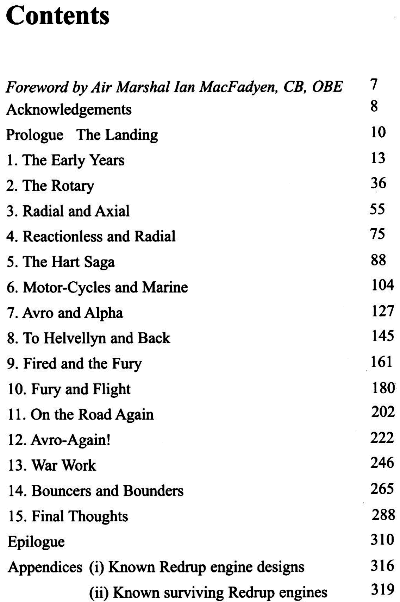
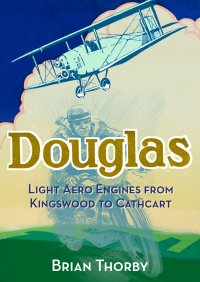 |
Douglas Light Aero Engines:
From Kingswood to Cathcart
by Brian Thorby
Paperback, 170mm x 240mm x 20mm, 232 pages
ISBN: 978-1-90659
Redcliffe Press Ltd (2010)
Recommended Retail Price: £16.95
Photos, drawings, charts, and diagrams
|
Reviewed by Bill Allan
Written by one of our members, this book tells the story of
the development of light aero engines, by the motorcycle company, Douglas, in
the Bristol area, and further developments at Weir Pumps in Glasgow.
Introduction — a three page brief history of the Douglas
Company, introduction to the motorcyclist and engineer, C. G. Pullin, who was
the major figure in the development of these engines, and the move to Glasgow,
where the development of the helicopter took place. An interesting point made
(which struck me) is that an explanation is given to horsepower rating, then,
and subsequently.
Forward — a one page statement from the great grandson of
the founder of the Douglas Company.
Chapter 1: Wings For Twins — ten pages, describing the
Under-Secretary for Air's 1923 incentive for the development of ultra-light
aircraft, in the UK, known as the Lympne (Kent) Light Aircraft Competition. One
page has a list of entrants and with one page of photographs, and each aircraft
and engine used is described. Subsequent to this was the 1924 Rhon Glider &
Light Aircraft Competition, and, again, one page lists the entrants, with a page
of photographs.
Chapter 2: Flying Flywheels — Fourteen pages, including
graphs, photographs, descriptions, installation drawings, (one page only) of the
use of Douglas motorcycle engines in aviation to 1932. The specification pages
give the facts and figures, including materials used. Finally, there is a one
page chronology of the Douglas aero engine developments.
Chapter 3: Dark Clouds Over Bristol — Short four page
chapter. Describes the takeover of Douglas, the start of work on an autogiro,
and the move North to Glasgow. Also, the start of specifically designed aero
engines.
Chapter 4: Designed To Fly — Sixteen pages, including seven
pages of photographs, three pages of drawings, and three pages of specification,
of the design of these new purpose built aero engines, to photographs being of
aircraft fitted with these engines. One fault — the aircraft in the lower
picture on page 56 is a Helmy Aerogypt, described later on in the book.
Chapter 5: Refinement By Proxy — Nineteen pages delving in
a more technical manner into the Weir engines, with three and a half pages of
photographs, three pages of engine specifications, and nine pages of technical
drawings plus sections of the engines and their features, including a patent
drawing for an oil cooler.
Chapter 6: Dreams Of Power — What Might Have Been. My
favourite part of the book. Twenty-three pages, much as the previous chapter,
with one and a half pages of photographs, a cutaway drawing of the Monarch
engine, nine pages of technical illustrations, and six pages of specifications
of engines planned for the future. Also describes what the company intended to
do if they continued.
Chapter 7: Competition — describes, usually, on one page,
the other engines that the Douglas/Weir engines were up against, mostly a half
page photograph and half page specification, and some of the aircraft fitted
with them. There are seventeen photographs in this chapter.
Chapter 8: The Airframes — Sixty-eight pages, forty eight
photographs, brief specifications of forty-nine/fifty aircraft fitted with
Douglas engines, and twenty-four pages of one-page three-views of some of the
aircraft fitted with Douglas engines.
Chapter 9: Auxiliary Power Units — this section would have
made an excellent article in Torque Meter (perhaps we could ask our
colleague for permission to download this part to the members section of the
website). Ten pages, describing generator sets, APUs, and aircraft
pressurisation tests, using Douglas engines. The design of the four-cylinder
starting engine for the R-R Eagle engine, if expanded, would also make an
excellent article. Seven photographs, one small cutaway drawing, and two pages
of sectioned drawings of this starter engine, in total.
Chapter 10: Survivors — Extant Engines and Airframes. Nine
pages, containing thirteen photographs.
Appendices — three appendices, listing light aero engines
produced by Douglas & Weir, data of aircraft fitted with these engines, and a
glossary of terms throughout the book including some specifications of the
materials used in the construction of the engines.
A one page bibliography, two pages of acknowledgements, and
a seven page index complete the book.
Note: all photographs are printed on the pages, not glossy
copies.
All in all, an excellent record, of this fascinating,
aeronautical achievement. I intend donating a copy to Glasgow University
library.
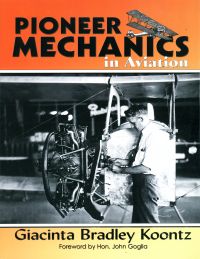 |
Pioneer Mechanics in Aviation
by Giacinta Bradley Koontz
Softcover, 114mm x 217mm x 8mm, 161 pages
ISBN: 0-9768554-3-7
Running Iron Publications (2011)
Recommended Retail Price: US $30.00
Kindle Edition: US $30.00
152 photographs and drawings |
Reviewed by Kimble D. McCutcheon
It is always a thrill when an AEHS member writes and publishes a book. Giacinta Bradley Koontz’s book Pioneer Mechanics in Aviation is no exception. “Gia” is probably best known for her columns and contributions to Aircraft Maintenance Technician, Ground Support Worldwide, Director of Maintenance, Helimx and Air & Space. She also authored The Harriet Quimby Scrapbook, the life of America’s First Birdwoman (1875-1912).
Based in part on her aforementioned columns, Pioneer Mechanics in Aviation is a series of 24 biographical vignettes about men and women whose names are both familiar and not. These include Charlie Taylor, Charles Manly, Fredrick Rentschler, Winfield Kinner, Katherine Stinson, Martin Sensenich, Bud Gurney, Bernard Pietenpol, Mary Solbrig, Jerosla Dobias, Willa Chappell, Phoebe Omlie and Ruth Nichols.
This book is different from most other books reviewed here in that it concentrates less on the technical and more on the people. Its production quality is excellent and its stories are wonderful. It has dozens of vintage photographs and a full set of references.







